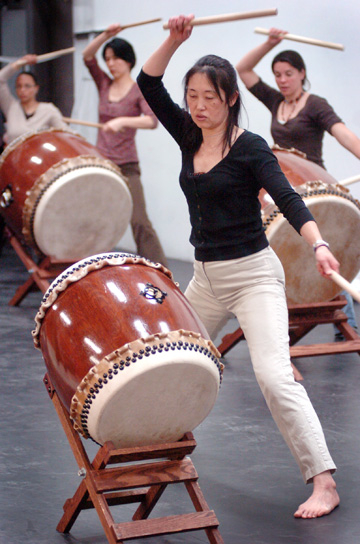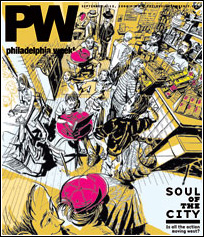Drumming Japanese.
Kyo Daiko, Philadelphia's only Japanese-style drumming crew, provides a heart-pounding experience.
From the March 24, 2009 Philadelphia Weekly.
After the lunges and other stretching, June Washikita O'Neill mans the odaiko, the large drum that is the heart of the ensemble.
With the 3-foot wide drum at her eye level, she gingerly taps a beat that slowly evolves into a thunderous, hair-raising rumble. Her arms rapidly pound the taut cow skin, with the bachi - thick, wooden drumsticks - becoming a blur. The two performers on the smaller, high-pitched shime drums begin thumping, and the rumble reaches a feverish pace.
Between beats, O'Neill and the dozen other members of Kyo Daiko, Philadelphia's only Japanese-style drumming crew, start shouting, "Eeeeeeii Ya Sa!"
They repeat the rhythmic, nonsensical phrase over and over again as the resonant roar fills the room and the energy builds. Then the remainder of the troupe joyously prance on to the stage, waving their bachi in the air, continuing to scream, "Eeeeeeii Ya Sa!"
After a dramatic pause, they each man a drum and the tribal-sounding beats erupt into an explosion of sound, matched by uniform choreographed movements, creating an avalanche of sight and sound.
"It's so much fun," shime drummer Audrey Tuckerman says after performing the song. "Taiko is so awesome."
***
The Kyo Daiko performers are a collection of people from various backgrounds, races and ages who share a love of the taiko experience.
"Kyo means cooperation in Japanese," explains Matt Palmer, 29, a founding member of the troupe. "Daiko means drum. So we are a community of drummers."
The group formed five years ago when O'Neill, then the executive director of the Japanese House and Garden in Fairmount Park, and Palmer, the House's site manager, grew frustrated by having to locate taiko troupes from elsewhere to perform at festivals and events at the Japanese House.
"We got really tired of doing that," says O'Neill, 50. "And it got really expensive."
Troupes can charge $1,000 or more for performances.
"We decided we needed our own community taiko group," she says.
They formed an arrangement with Settlement Music School, which provided a faculty member, Kris Rudzinski, to be the teacher and artistic director.
At first, they didn't even have drums, which can cost more than $2,000 per instrument. Instead, they practiced on automobile tires wrapped in clear packing tape. With time, the group became more polished. They now boast 12 drums, including several imported from Japan, and around 15 members who show up for weekly practices at Settlement's West Philadelphia branch.
Last year, they performed at 23 events - weddings, festivals, business openings and conferences.
"Every time we play, we pick up a few new people," says O'Neill. "Anyone who wants to put in the time can be a part of it."
In the spring, they'll offer classes to beginners at the Asian Arts Initiative on Vine Street. And they'll play at Sakura Sunday, part of the Cherry Blossom Festival, at the Japanese House on April 5.
***
Meanwhile, Rudzinski, 35, rides the group hard.
"We don't exaggerate our moves enough!" he bellows after practicing the piece.
A Rowan University grad trained in African and steel drums, Rudzinski spreads his legs, forming a low, wide base, and then demonstrates the exaggerated moves - snapping his hands toward the drum, sweeping the bachi in the air, ending in a striking pose with his right hand behind him, the bachi pointing straight back.
"We want to be big," he adds. "That's what taiko is: big!"
***

Taiko drums have been traced back hundreds of years in Japan, used at festivals, during battles and as a way to communicate over vast distances. Traditionally, only one or two drums were used at a time. During the 1950s, Japanese jazz drummer Daihachi Oguchi experimented with taiko ensembles - numerous drums at once, played with precise, elaborate movements.
Taiko quickly became popular in Japan. It spread to America in the 1960s as Japanese-Americans began acknowledging a heritage many had shelved following World War II xenophobia, when more than 100,000 Japanese and Japanese-Americans had been interned in War Relocation Camps.
"It was rooted in the civil rights movement," Palmer says. "For people of Japanese ancestry, taiko was a way to reclaim their culture."
There are now around 4,000 taiko groups in Japan, 150 in North America and dozens more around the world.
***
"Half of it is the choreography, the movement, and half of it is the actual drumming," O'Neill says. "It's a very physical performance. It's very tiring."
O'Neill was born in Japan to a Japanese mother and American serviceman father. She came to America when she was 5. She now manages the Philadelphia Cultural Fund, a nonprofit that offers grants to city arts programs.
"I've started working out because it's hard to get through it if you don't have the stamina," she says.
After the two-hour practice session, the members are sweaty but smiling.
"If we're doing it right," Palmer says as he points to his torso, "when we finish, we should hurt like hell right here."








